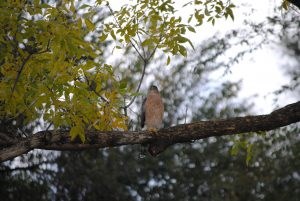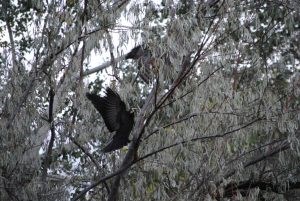This content was originally published by the Longmont Observer and is licensed under a Creative Commons license.
Longmont is, perhaps surprisingly, home to several urban raptors. If you keep a look out at this time of year, you may be lucky enough to spot one of these birds. About a month ago, I was lucky enough to spot a Cooper’s hawk several times over the course of a few weeks. The first time, I caught the hawk hunting crows and the second time, the hawk was hunting a very unaware squirrel. I didn’t know much about the biology of Cooper’s hawks, so I will be focusing on them in this column.
Cooper’s hawks belong in a group of hawks called accipiters. Accipiters are hawks that live in wooded areas and their bodies are specially designed to allow them to hunt in that environment. Their wings are short and rounded and their tails are long and act as a rudder. This allows them to maneuver through the trees quickly while hunting without crashing into them. In flight, they will flap several times and then glide.

Cooper’s hawks are about the size of a crow. They are 15-20 inches long with a wing span of 27-36 inches. Hawks in the western US tend to be smaller than their eastern counterparts. Cooper’s hawks are a steely-blue color on the back with reddish colored bars on the breast. The tail has several thick, dark bands. In contrast, juveniles are brown in color on the back with brown streaks on the breast. Cooper’s hawks look very similar to sharp-shinned hawks, making identification tricky. Sharp-shinned hawks are also accipiters. Differentiating between the two species is a classical birding challenge and details about identifying the two can be found on Audubon’s website.
As already mentioned, Cooper’s hawks are accipiters and therefore they live primarily in wooded areas. In urban areas they are also sometimes found at bird feeders looking for a quick, easy meal. At one point, Cooper’s hawks were thought to be relatively rare in the city. However, recent studies have shown that in some areas, the population of Cooper’s hawks in the city may be higher than in rural wooded areas. This is because there are lots of pigeons and doves in the city for the hawks to eat. Apparently, the nestlings of Cooper’s hawks can contract a parasitic infection from the parents eating doves.
Cooper’s hawks eat primarily birds, but will also eat small mammals, particularly in the western US. Common birds that are eaten include pigeons, doves, starlings, robins, jays, and chickens. Cooper’s hawks move from perch to perch in dense woods, listening and watching for prey. Once prey is spotted, the Cooper’s hawk put on a burst of speed, maneuvering through the trees to catch their prey. Prey is captured by the feet and is killed by repeated squeezing of the talons. Cooper’s hawks have also been known to drown their prey. As you might imagine, hunting in wooded areas can be tricky. Studies of 300 Cooper’s hawks skeletons showed that 23 percent had old fractures that had healed over, particularly in the wishbone.

During courtship, the male Cooper’s hawk will beat its wings slowly a few times and then glide with the wings in a v-shape. The males also make a bowing display to the female before the pair bond forms and again before building the nest. Males are smaller than females and there is always a danger they could become prey. Because of this, males are submissive to the females and when females are receptive to being approached, they make a particular call to reassure the male.
The male actually builds the nest, which takes about two weeks to complete. Nests are comprised of sticks and are about 27 inches in diameter and 6-17 inches high. The middle of the nest contains a depression that is about eight inches in diameter and four inches deep, lined with strips of bark and green twigs. Nests are built in tall trees about 25-50 feet off the ground in a tree crotch or on a horizontal branch. The male also feeds the female for about a month before she lays eggs.
The female lays two to six eggs per clutch and rears only one brood per year. Males bring food to the female throughout the incubation period which lasts for 34-36 days. While the female is eating the male will incubate the eggs. For the first two weeks after the eggs hatch, the female broods the young. The male will bring food to the nest and the female will then feed it to the young. About four weeks after hatching, the young will begin to climb around in the tree and five weeks after hatching, they will begin to fly.
To find these hawks, you can first try listening for them. Cooper’s hawks make a cack-cack-cack sound. Males also make a whistling sound. You can also look for birds flying with the typical flap-flap-flap-glide flight pattern and look for birds with long tails. If you happen to have a bird feeder that a Cooper’s hawk has honed in on and you don’t want them there, you can remove the seed for a few days and the hawk will usually move on. The next time you are in a wooded park area, watch for these amazing flyers.


